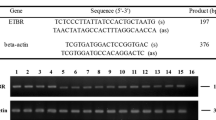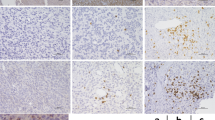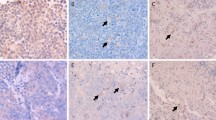Abstract
Fas (APO-1/CD95) ligand (FasL) and its receptor, Fas, play a key role in the regulation of apoptosis in the immune system. FasL acts as a cytotoxic effector molecule to Fas-expressing malignant tumor cells; however, it has recently been suggested that FasL also acts as a possible mediator of tumor immune privilege. We studied FasL expression in glioblastoma cell lines and a series of human glioma specimens by Western blotting and immunohistochemistry. In addition, quantitative analysis of T-cell infiltration in these tumors was performed. FasL expression was seen in all cell lines and in 9 of 14 specimens by Western blotting and immunohistochemistry. The distribution of FasL was recognized in the cytoplasm of tumor cells (5 of 9) and in the vascular endothelium (4 of 9). Both types of FasL expression were associated with a significant reduction (p<0.05) in T-cell infiltration when compared with FasL-negative areas within the same tumor or FasL-negative specimens. Since T-cell apoptosis could be induced by FasL-expressing tumor cells, the present findings suggest that apoptosis induction by FasL expressed on tumor cells and/or vascular endothelium might be one mechanism for T-cell depletion in astrocytic tumor tissues.
Similar content being viewed by others
References
Streilein JW (1995) Unraveling immune privilege. Science 270:1158–1159
Fabry Z, Raine CS, Hart MN (1994) Nervous tissue as an immune compartment: the dialect of the immune response in the CNS. Immunol Today 15:218–224
Suda T, Takahashi T, Golstein P, et al (1993) Molecular cloning and expression of Fas ligand, a novel member of the tumor necrosis factor family. Cell 75:1169–1178
Nagata S, Golstein P (1995) The Fas death factor., Science 267:1449–1456
Griffith TS, Brunner T, Fletcher SM, et al (1995) Fas lignandinduced apoptosis as a mechanism of immune privilege. Science 270:1189–1192
Bellgrau D, Gold D, Selawry H, et al (1995) A role for CD95 ligand in preventing graft rejection. Nature 377:630–632.
O'Connell J, O'Sullivan GC, Collins JK, et al (1996) The Fas counterattack: Fas-mediated T cell killing by colon cancer cells expressing Fas ligand. J Exp Med 184:1075–1082
Hahne M, Rimildi D, Schroter M, et al (1996) Melanoma cell expression of Fas (Apo-1/CD95) ligand: implications for tumor immune escape. Science 274:1363–1366
Strand S, Hofmann WJ, Hug H, et al (1996) Lymphocyte apoptosis induced by CD95 (Apo-1/Fas) ligand-expressing tumor cells: a mechanism of immune evasion? Nature Med 2:1361–1366
Niehans GA, Brunner T, Frizelle SP, et al (1997) Human lung carcinomas express Fas ligand. Cancer Res 57:1007–1012
Saas P, Walker PR, Hahne M, et al (1997) Fas ligand expression by astrocytoma in vivo: maintaining immune privilege in the brain? J Clin Invest 99:1173–1178
Bennett MW, O'Connell J, O'Sullivan GC, et al (1998) The Fas counterattack in vivo: apoptotic depletion of tumor-infiltrating lymphocytes associated with Fas ligand expression by human esophageal carcinoma. J Immunol 160:5669–5675
Tanaka M, Suda T, Takahashi T, et al (1995) Expression of the functional soluble form of human Fas ligand in activated lymphocytes. EMBO J 14:1129–1135
Tanaka M, Suda T, Haze K, et al (1996) Fas ligand in human serum. Nature Med 2:317–322
Parums D, Cordell JL, Micklem K, et al (1990) JC70, a new monoclonal antibody that detects vascular endothelium associated antigen on routinely processed tissue sections. J Clin Pathol 43:752–757
Sata M, Walsh K (1998) TNFα regulation of Fas ligand expression on the vascular endothelium modulates leukocyte extravasation. Nature Med 4:415–420
Knip** E, Debatin K-M, Stricker K, et al (1995) Identification of soluble APO-1 in supernatants of human B- and T-cell lines and increased serum levels in B- and T-cell leukemias. Blood 85:1562–1569
Owen Schaub LB, Angelo LS, Radinsky R, et al (1995) Soluble Fas/APO-1 in tumor cells: a potential regulator of apoptosis? Cancer Lett 94:1–8
Tachibana O, Nakagawa H, Lampe J, et al (1995) Expression of Fas/APO-1 during the progression of astrocytomas. Cancer Res 55:5528–5530
Natoli G, Ianni A, Costanzo A, et al (1995) Resistance to Fasmediated apoptosis in human hepatoma cells. Oncogene 11:1157–1164
Cascino I, Papoff G, De Maria R, et al (1996) Fas/Apo-1 (CD95) receptor lacking the intracytoplasmic signaling domain protects tumor cells from Fas-mediated apoptosis. J Immunol 156:13–17
O'Connell J, Bennett MW, O'Sullivan GC, et al (1997) The Fas counterattack: a molecular mechanism of tumor immune privilege. Mol Med 3:294–300
Itoh N, Tsujimoto Y, Nagata S (1993) Effect of bcl-2 on Fas antigen-mediated cell death. J Immunol 151:621–627
Wellar M, Malipiero U, Aguzzi A, et al (1995) Protooncogene bcl-2 gene transfer abrogates Fas/APO-1 antibody-mediated apoptosis of human malignant glioma cells and confers resistance to chemotherapeutic drugs and therapeutic radiation. J Clin Invest 95:2633–2643
Jaattela M, Benedict M, Tewari M, et al (1995) Bcl-x and bcl-2 inhibit TNF and Fas-induced apoptosis and activation of phospholipase A2 in breast carcinoma cells. Oncogene 10:2297–2305
Bargou RC, Daniel PT, Mapara MY, et al (1996) Overexpression of the death-promoting gene bax-α which is downregulated in breast cancer restores sensitivity to different apoptotic stimuli and reduces tumor growth in SCID mice. J Clin Invest 97:2651–2659
Sato T, Irie S, Kitada S, et al (1995) FAP-1: a protein tyrosine phosphatase that associates with Fas. Science 268:411–415
Ungefroren H, Voss M, Jansen M, et al (1998) Human pancreatic adenocarcinomas express Fas and Fas ligand yet are resistant to Fas-mediated apoptosis. Cancer Res 58:1741–1749
Okura T, Gong L, Kamitani T, et al (1996) Protection against Fas/Apo-1 and tumor necrosis factor-mediated cell death by novel protein, sentrin. J Immunol 157:4277–4281
Pitti RM, Marsters SA, Lawrence DA, et al (1998) Genomic amplification of a decoy receptor for Fas ligand in lung and colon cancer. Nature 396:699–703
Author information
Authors and Affiliations
Corresponding author
Rights and permissions
About this article
Cite this article
Ichinose, M., Masuoka, J., Shiraishi, T. et al. Fas ligand expression and depletion of T-cell infiltration in astrocytic tumors. Brain Tumor Pathol 18, 37–42 (2001). https://doi.org/10.1007/BF02478923
Received:
Accepted:
Issue Date:
DOI: https://doi.org/10.1007/BF02478923




